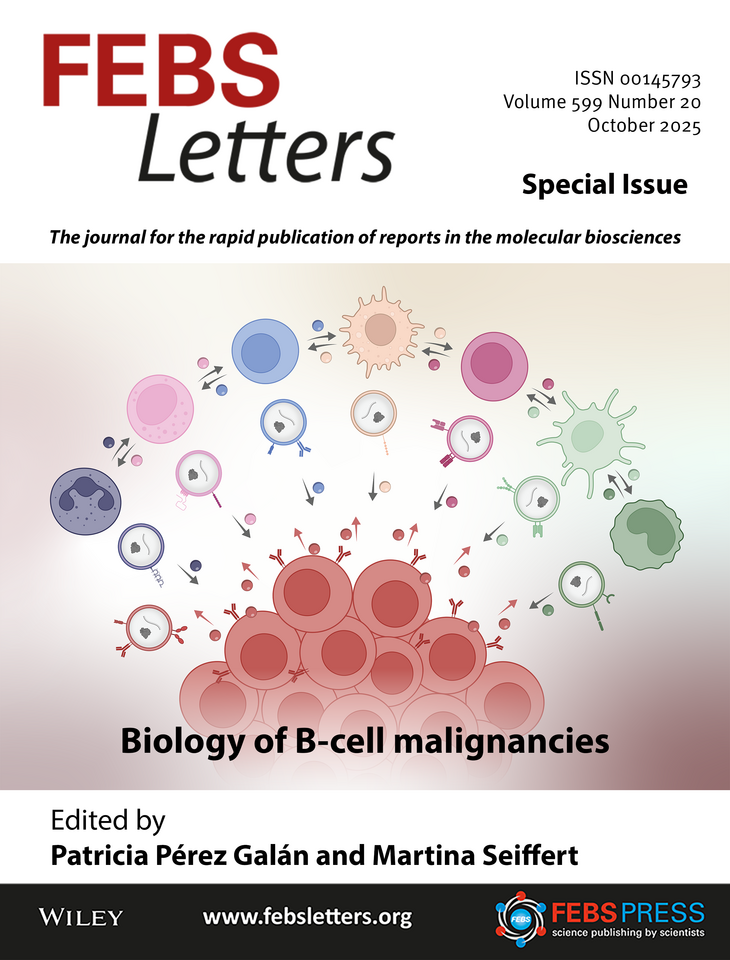Special Issue: Biology of B-cell malignancies

B-cell neoplasms are remarkably adaptive malignancies that sustain themselves by leveraging interactions within the tumor microenvironment. Recent advances in molecular biology, single-cell technologies, mechanobiology, and extracellular vesicle research have revealed unprecedented insights into how tumor cells communicate with stromal and immune components to promote survival, develop therapy resistance, and escape immune surveillance. The FEBS Letters' newest Special Issue "Biology of B-cell malignancies", guest-edited by Patricia Pérez-Galán and Martina Seiffert features a collection of manuscripts showcasing integrative perspectives on signaling, mechanics, and immune interactions in B-cell malignancies.
In this Special Issue, two manuscripts focus on the interactions between B-cell malignancies and the tumor microenvironment, one in a review format [1] and the other in the format of a graphical review [2]. Another two reviews, explore the effects of mechanical forces in malignant transformation [3], as well as how the cytoskeletion and integrins participate in mechanotransduction both in healthy and malignant B-cells [4]. Moreover, a review explores the importance and disregulation of B- and T-cell interactions, highlighting the roles of T cells in B-cell lymphoma pathogenesis, progression, and therapy response [5]. Finally, two reviews focus on the molecular basis of B-cell transformation, exploring possible therapeutic targets as well as challenges [6,7], and another manuscript focuses on how 3D biological systems can help in the advancement of lymphoma research [8].
These studies collectively explain how B-cell malignancies integrate cues from their microenvironment, intracellular signaling pathways, and immune interactions to ensure survival and evade therapy. Together, they underscore a crucial lesson: durable therapeutic success will depend on approaches that not only target malignant cells but also disrupt their supportive niches, modulate mechanical and signaling dynamics, and restore effective immune responses.
Read more of the Editorial here:
https://febs.onlinelibrary.wiley.com/doi/10.1002/1873-3468.70180
Or check out the full Special Issue:
https://febs.onlinelibrary.wiley.com/toc/18733468/2025/599/20
[1] Gardano, L., Ferreira, J., Le Roy, C., Ledoux, D. and Varin-Blank, N. (2025), The survival grip–how cell adhesion promotes tumor maintenance within the microenvironment. FEBS Lett, 599: 2834-2853. https://doi.org/10.1002/1873-3468.15074
[2] Bachurski, D. and Hallek, M. (2025), Biological and technical complexities in analyzing extracellular vesicle immune interactions in B-cell malignancies. FEBS Lett, 599: 2952-2953. https://doi.org/10.1002/1873-3468.70102
[3] Sampietro, M., Cellani, M. and Scielzo, C. (2025), B cell mechanobiology in health and disease: emerging techniques and insights into therapeutic responses. FEBS Lett, 599: 2854-2877. https://doi.org/10.1002/1873-3468.70071
[4] Pethe, A. and Hartmann, T.N. (2025), The cytoskeletal control of B cell receptor and integrin signaling in normal B cells and chronic lymphocytic leukemia. FEBS Lett, 599: 2878-2895. https://doi.org/10.1002/1873-3468.70045
[5] Llaó-Cid, L. (2025), Single-cell insights into the role of T cells in B-cell malignancies. FEBS Lett, 599: 2932-2951. https://doi.org/10.1002/1873-3468.70099
[6] Hlavac, K., Pavelkova, P., Ondrisova, L. and Mraz, M. (2025), FoxO1 signaling in B cell malignancies and its therapeutic targeting. FEBS Lett, 599: 2911-2931. https://doi.org/10.1002/1873-3468.15057
[7] Buchner, M. (2025), Insights into PI3K/AKT signaling in B cell development and chronic lymphocytic leukemia. FEBS Lett, 599: 2896-2910. https://doi.org/10.1002/1873-3468.15079
[8] Faria, C., Dobaño-López, C., Pérez-Galán, P. and Bezombes, C. (2025), Goodbye flat lymphoma biology. FEBS Lett, 599: 2954-2972. https://doi.org/10.1002/1873-3468.70114



Join the FEBS Network today
Joining the FEBS Network’s molecular life sciences community enables you to access special content on the site, present your profile, 'follow' contributors, 'comment' on and 'like' content, post your own content, and set up a tailored email digest for updates.